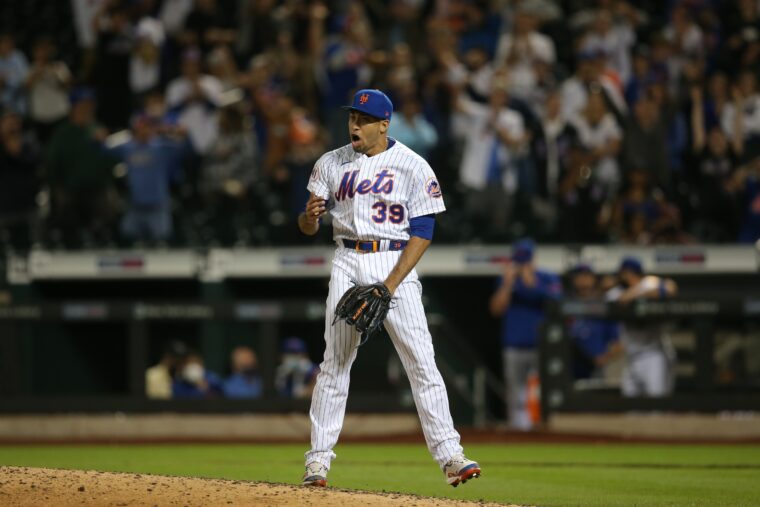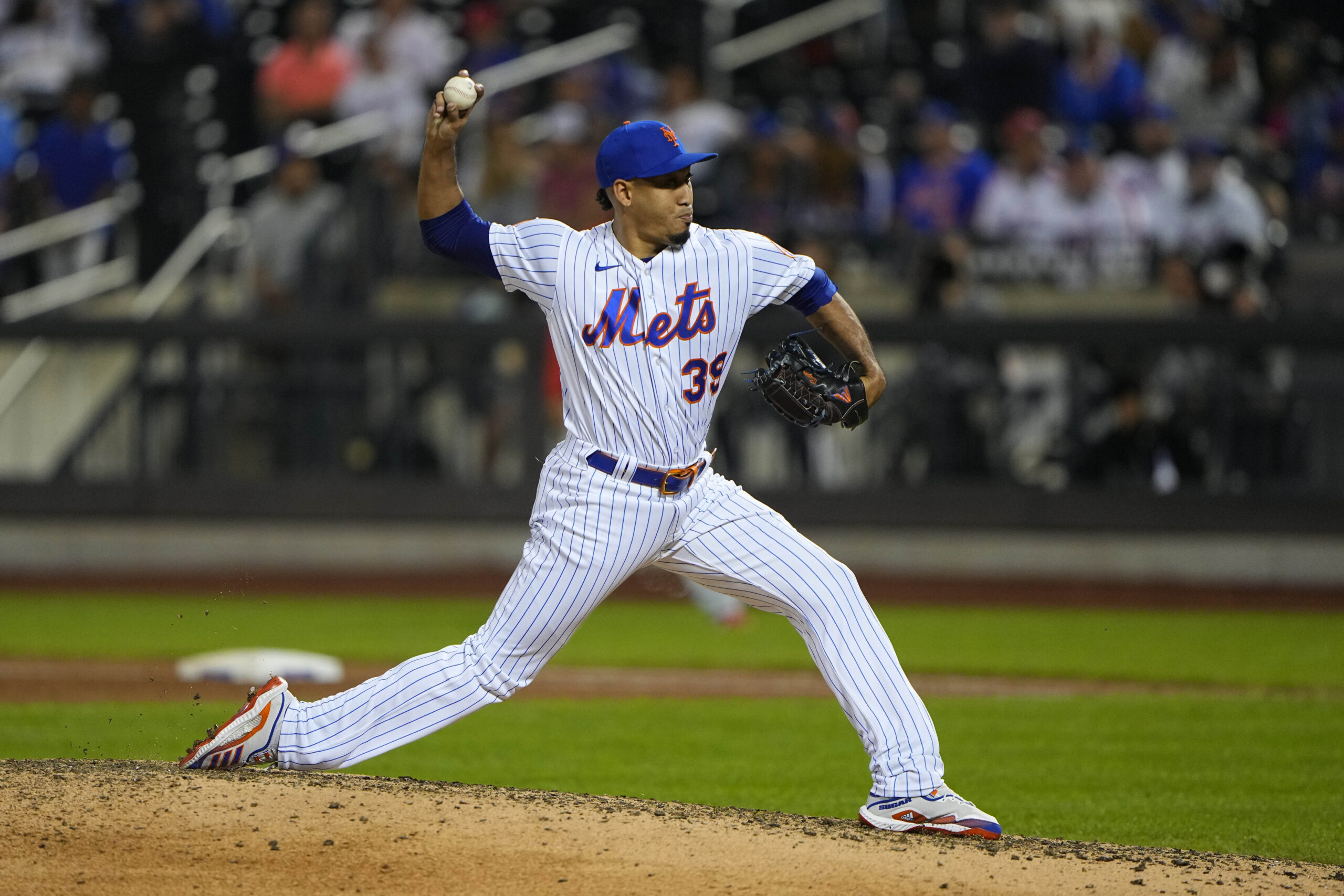
Mandatory Credit: Brad Penner-USA TODAY Sports
Following a disastrous 2019 campaign, closer Edwin Diaz took many strides in the right direction during the shortened 60-game season in 2020, and while the New York Mets won’t be playoff bound this season, he’s continued to return to his dominating form.
The 2021 season has featured several highs and lows for the Mets, most of which the fanbase probably wants to forget once the regular season draws to a close. Though there’s currently a ton of disappointment surrounding this team, understandably, none of that should apply to the backend of their bullpen as it’s been an area of strength all year long.
Headlined by Diaz at the closer’s position, this team has counted on a very reliable group of relievers in late-game situations, including Trevor May, Aaron Loup and Jeurys Familia.
More specifically, Diaz has been extremely reliable in high-leverage spots – there hasn’t been nearly enough of those for this club this season – for a second straight campaign. While there were some concerns about his ability to build off his success from the 2020 season, he’s done everything and more of what the coaching staff has asked of him this time around.
Despite a few bumps along the way, for the most part, the 6’3″ hurler has excelled on the mound in his third season with the Mets, resulting in a 3.50 ERA, 2.53 FIP, .194 OPP AVG, 34.3% strikeout rate, 9.1% walk rate and a 1.9 fWAR — highest since 2018 — over 61 2/3 innings pitched.
For Diaz, though he enjoyed a remarkable bounce-back performance last season, where he posted a 1.75 ERA, 2.18 FIP and a 0.9 fWAR through 25 2/3 innings, allowing hard contact remained one of his biggest issues.

Credit: Gregory Fisher-USA TODAY Sports
Due to his 38.6% hard-hit rate against and 6.8% barrel rate against, the 27-year-old posted slightly inflated expected results, including a 2.54 xERA, 2.29 xFIP and a .360 xwOBAcon. While these concerning metrics didn’t prevent him from exceeding expectations, it was an area he needed to improve in heading into the 2021 season.
Thankfully, Diaz has come a long way in that department since then and has improved his ability to prevent opposing batters from generating exit velocities of 95 mph or higher against him. In turn, he’s witnessed significant improvements in his hard-hit and barrel rates against along with some of his expected results as well.
Correcting one of the largest flaws of his craft, the right-hander has posted the best hard-hit rate against (26.7%) and xwOBAcon (.313) of his professional career. In addition, he’s also recorded an impressive 5.2% barrel rate against and a 2.69 xERA.
Taking this a step further, the former third-round selection currently owns the fifth-best hard-hit rate against among all relievers in the majors who’ve compiled at least 50.0 innings this season, according to FanGraphs.com.
One of the few expected metrics that hasn’t favored Diaz in 2021 has been xFIP, however, that’s because one of its main components is calculating how many home runs a pitcher should’ve allowed based on his fly ball percentage.
For the Mets’ closer, he’s allowed significantly more fly balls this season compared to the one before, which has seen his FB rate climb to 42.7%, an 8.6% increase from 2020. But since he’s barely surrendered any hard contact, his 3.50 xFIP can probably be dismissed for right now, especially since he owns a career-best 5.4% FB/HR ratio.
Unlike previous seasons, Diaz has solely relied on his high-90s fastball and low-90s slider in 2021, cutting out his high-90s sinker and mid-90s changeup from his arsenal. While his breaking ball has served as his primary strikeout weapon, his heater has played a crucial role in helping him reduce the amount of hard contact allowed.
In order to accomplish this feat, the hard-throwing righty needed to slightly alter his mechanics involving his four-seamer, which has seen him increase his average extension by two inches (7.3 feet in ’21). In turn, this has improved its average velocity by an extra tick, as it’s risen to 98.8 mph (97.8 mph in ’20).
Thanks to these adjustments, opposing batters haven’t been able to catch up to Diaz’s fastball like they were able to at times last season, resulting in plenty of late contact. Granted, its whiff rate hasn’t increased due to these changes, in fact, it’s decreased by 15.5%. However, all those late swings have translated into a ton of soft contact, which has worked to his advantage.

Source: BaseballSavant.com
After allowing a 90.6 mph average exit velocity against his four-seamer in 2020, Diaz has taken major strides in just one season, improving to a career-best 87.0 mph average exit velocity in 2021.
Building off that, the 2018 American League All-Star’s heater has also witnessed significant progress regarding its hard-hit rate against, as it’s improved from 48.8% last season to a career-best 28.2% this season, which is fourth-best among all pitchers who’ve ended at least 100 PAs with their fastball, according to BaseballSavant.com.

Source: BaseballSavant.com
Similar to the case against his current xFIP, the expected metrics against Diaz’s four-seamer have all climbed considerably compared to last season due to its 29.4% FB rate (8.0% in ’20). As a result, its xAVG has increased by .055 (.222 in ’21), its xSLG by .080 (.353 in ’21) and its xwOBA by .051 (.314 in ’21).
But since his fastball has surrendered very little hard contact, these increases hold very little weight behind them and aren’t a cause for concern. Sure, they’ll probably require monitoring throughout the 2022 campaign, although they shouldn’t become an issue as long as he maintains his current quality-of-contact metrics.
Along with improving his overall contact results, Diaz has also walked fewer batters with his four-seamer this season, as its walk rate has lowered from 14.8% in 2020 to 9.9%. Since his fastball featured the highest walk rate among all of his pitches last season, this development has allowed his overall walk rate to decrease by 3.6% – the second-largest season-by-season improvement of his career.
It only took a frustrating 2019 season, multiple COVID-19 related stops and starts in 2020, but the Mets appear to finally possess the shutdown closer they had envisioned when he was acquired – by the former regime – during the 2018-19 offseason.
Slated to enter his age-28 season in 2022, it seems Diaz isn’t ready to slow down anytime soon, and considering he’ll be entering his final year of arbitration next season, that probably bodes well for him. Since he’s nearing free agency, chances are both sides will likely hold contract negotiations over the winter, which could prove to be very lucrative for the Puerto Rican native.
Paired with his prior success with the Seattle Mariners, the explosive righty has returned to his elite form since 2020 and it’d be horrifying to imagine how the Mets’ bullpen would move forward without him leading the charge. Hopefully, that situation doesn’t come to pass for a very long time.















